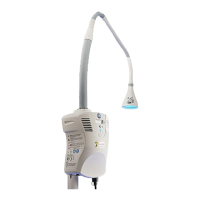NOTE 3: Electromagnetic propagation is aected by absorption and reection from structures, objects, and
people.
a. Field strengths from xed transmitters such as base stations for radio, cellular/cordless telephones and
land mobile radios, amateur radios, AM and FM radio broadcasts and TV broadcasts cannot be predicted
theoretically with accuracy. To assess the electromagnetic environment due to xed RF transmitters,
an electromagnetic site survey should be considered. If the measured eld strength in the location in
which the Girae Blue Spot PT Lite unit is used exceeds the applicable RF compliance level above, the
unit should be observed to verify normal operation. If abnormal performance is observed, additional
measures may be necessary, such as reorienting or relocating the Girae Blue Spot PT Lite.
b. Over the frequency range 150 KHz to 80 MHz eld strengths should be less than 3 V/m.
13.4.1 Recommended Separation Distance Between Portable and Mobile RF Communications
Equipment and the Girae Blue Spot PT Lite
The Girae Blue Spot PT Lite is intended for use in an electromagnetic environment in which radiated RF
disturbances are controlled. The customer or the user of the Girae Blue Spot PT Lite can help prevent
electromagnetic interference by maintaining a minimum distance between portable and mobile RF
communications equipment (transmitters) and the Girae Blue Spot PT Lite as recommended below,
according to the maximum output power of the communications equipment.
Rated Maximum
Output Power of
Transmitter (W)
Separation Distance According to Frequency of Transmitter (m)
150 KHz to 80 MHz
d =1.2√ P
80 MHz to 800 MHz
d =1.2√ P
800 MHz to 2.5 GHz
d =2.3√ P
0.01 0.12 0.12 0.23
0.1 0.38 0.38 0.73
1.0 1.2 1.2 2.3
10.0 3.8 3.8 7.3
100.0 12.0 12.0 23.0
For transmitters rated at a maximum output power not listed above, the recommended separation distance
(d) in meters (m) can be estimated using the equation applicable to the frequency of the transmitter,
where P is the maximum output power rating of the transmitter in watts (W) according to the transmitter
manufacturer.
NOTE: At 80 MHz and 800 MHz, the separation distance for the higher frequency range applies.
NOTE: These guidelines may not apply in all situations. Electromagnetic propagation is aected by
absorption and reection from structures, objects and people.
93
Chapter 13: Electromagnetic Guidance and Declarations

